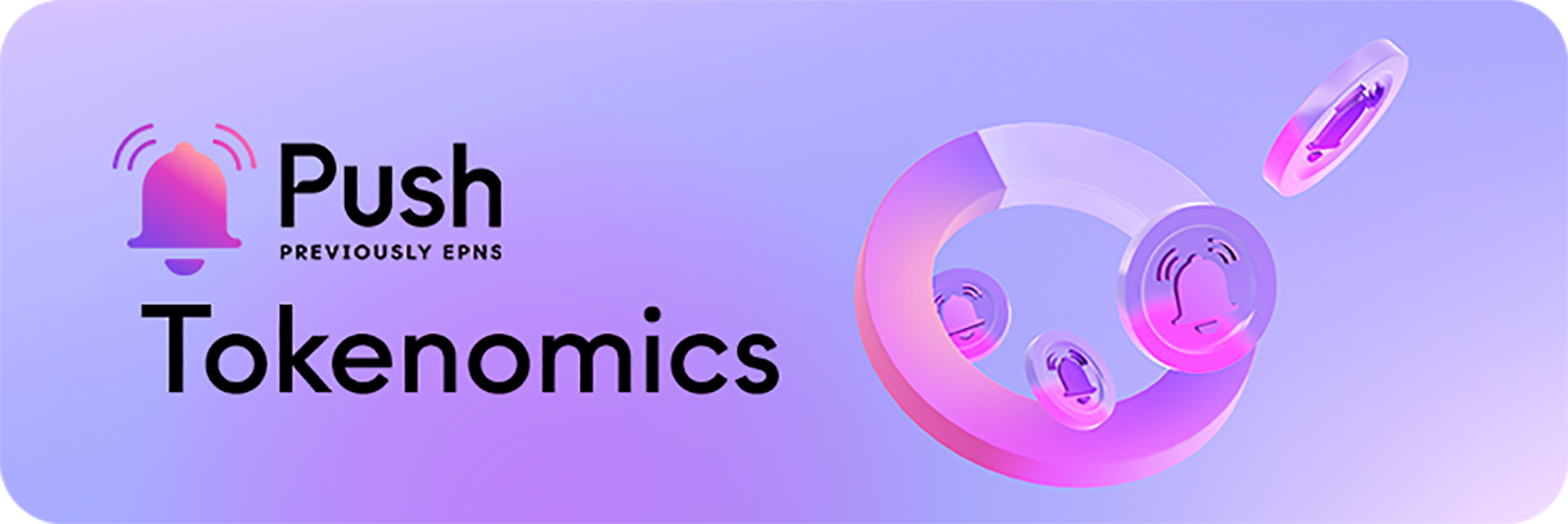Tokenomics overview
Breaking down the utility of the $PUSH for Push Protocol. Push Protocol is a web3 communication network that enables cross-chain notifications, chat, & messaging for dapps, wallets, users, & services.

What's the need?
Push Protocol aims to achieve a circular economy for its protocol by engendering a communication layer that is run by the community and for the community. The goal is for every participant to be rewarded for their participation while simultaneously discouraging behaviour that would be detrimental to the network.
$PUSH is the native token of Push Protocol. It achieves the circular economy today through four major use cases: securing the network, reward pool fee, network utility and Push DAO / governance.
Push Protocol and $PUSH are evolving as we add more forms of communications and spread to more chains. It is therefore likely that more utilities for $PUSH will emerge in addition to the four primary ones listed below.
Furthermore, some token use cases are currently in development and are not yet live. Push Protocol is building the de facto communication layer of web3. The roadmap for the next few years will launch additional token utility as those technical developments emerge.
Token Utility
Securing the Network
Push Nodes are an integral part of the Push Protocol. They can be run by anyone and they allow the network not only to facilitate communication, but to do so on multiple blockchains — while retaining governance on the Ethereum mainnet.
$PUSH is the incentive token used in Proof of Stake to keep the node operators acting in the best interest of the network.
Push Nodes that continue to reach consensus and operate in the best interest of the Push Protocol are rewarded in $PUSH. Conversely, Push Nodes that do not remain synced with consensus or attempt to damage the network are slashed, affecting the $PUSH they staked.
Push Fee Pool
The fee pool of Push Protocol allows for participants to be rewarded, achieving the “circular economy.” As progressive decentralization continues, the community will be able to define fees on the network, including:
- Charging
$PUSHfrom “super users” of chat and notifications, offering them more storage and premium features (analogous to Telegram premium). - Charging
$PUSHfrom protocols that are sending massive amounts of notifications. - Charging
$PUSHfor the utility features of the protocol.
All fees will be charged at the protocol level, with the goal to distribute fees to $PUSH token holders and crypto wallets that adopt Push Protocol. $PUSH has a time-weighted feature built into the token, which will allow the protocol to determine and reward the longest holders of the token proportionally.
$PUSH token holders will also be in charge of determining the fee split among themselves and the crypto wallets that adopt Push Protocol. This will occur through on-chain governance as the community updates the mechanics of the network.
Utility features of the Protocol
As a community-run middleware, Push Protocol can be updated and modified by the network of governance voters. Certain protocol settings and fees that could be updated include:
Active- Fees for activating your ProtocolActive- Fees for changing information of your existing protocolActive- Fees for enabling / disabling your channel- Fees for value-added services of the protocol
- Fees for sending notifications after a certain limit is reached
- Defining Spam throttle limit to ensure notifications are not abused
- Other settings for chat and other forms of communication
All network fees are charged in $PUSH starting with Push Protocol v2.
Push DAO and Governance
53% of the supply of $PUSH has been allocated to the community so together they can define the future of Push Protocol and its development. A part of which will eventually be in complete control of DAO.
$PUSH also gives owners the right to vote on protocol decisions, including the staking structure, staking mechanism, and reward distribution rates. Governance votes can include the structure of the fees paid by services (i.e. per notification or yearly subscription), the DeFi mechanism for the staking pool (i.e. staking through AAVE or elsewhere), and other critical incentivization and financial elements of the protocol.